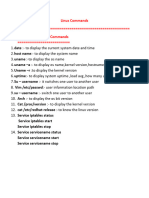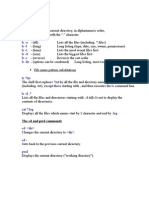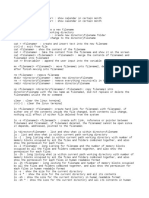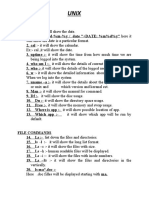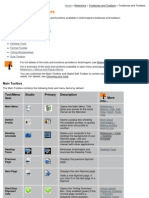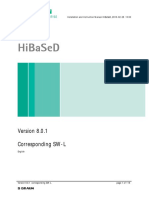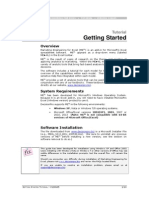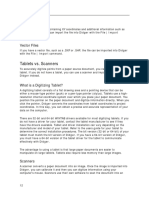NAME: Prasanna Pawar
Sr.
Command Argument Purpose
No.
1. To create file
1 vi vi file_name 2. To editing existing file (Press I, make changes, press ESC, :wq!
(Save and Exit), :q!(Exit without saving)
Provides a quick summary of a command’s usage.
2 help [command] --help
Displays basic options and their descriptions.
Provides a detailed manual for a command.
3 man man [command] Includes sections like description, options, examples, exit status,
and author.
cat file_name Viewing Content of File (all the data)
cat -n file_name number all output lines
4 cat
cat -b file_name number nonempty output lines
cat -s file_name suppress repeated empty output lines
It also show the content in file but only limited (fit in to 1 window
5 more more file_name
that much only)
It shows the current path or currently where we are (current
6 pwd pwd file_name
directory)
It list down what we have in our directory (current)
It list down what we have in our directory (current) but in more
ls -l
details (like date of file creation..etc)
7 ls
ls -lt It list down all files according to Date of Creation (ASC)
ls -ltr It list down all files according to Date of Creation (DESC)
ls -a It shows the hidden files
wc file_name It show the count of file (line count, word count, charcater count)
wc -l file_name It will show the count of Lines
8 wc wc -m file_name It will show the count of Charcaters
wc -c file_name It will show the Bytes count
wc -w file_name It will show the count words
9 mv file_name /path/to/move/newfile_name Move with New Name
mv mv file1 file2 /path/to/move/ Multiple files to move
mv file_name destination_directory To move file
mv mv myfolder /path/to/move/ moving directory
mv file_name new_file_name To rename the file
10 cp cp file_name file_name1 Copy the file
rm file_name To remove the file
11 rm rmdir directory_name remove directory but directory must empty
rm -r directory_name remove directory even if it is not empty
Creating Directories (means Folder)
mkdir Directory_Name For creating Directory
mkdir Directory1 Directory2… DirectoryN It create multiple directories at a time
12 mkdir
'-p' helps to Create parent directories as needed (If any Directory
mkdir -p ./ Directory1/Directory2 we give in path not exist then it create)
'./' It means start where you are
For doing operations on Directory
cp -r Source Destination Copy the file
cp -r Source Source1 Source2 Destination Copy the Multiple File
cp -r File1 Directory1 File2 Directory2 Destination Copy Mix files and Directories
13 command -r
rm -r Directory Removing Directory or Directories
rmdir Directory1 Directory2 For rmdir Directory must be empty otherwise it's not work
mv Directory Directory_New_Name Rename the directory Name
cd To go to the home directory, just use cd with no parameters
cd /user/home/tsrdj To go to the /user/home/tsrdj Directory (It is called Full Path)
cd ./Directory_Name To go 1 Directory Forward (It is called Relative Path)
cd- To go last used Directory
14 cd
cd .. To go to the 1 Directory back
cd ../.. To go to the 2 Directory back
To go to the 3 Directory back (We can ../../.. As per our need how
cd ../../..
many directory we have to go back)
head head files_name It will show the FIRST 10 lines of its standard output
15
head head -n file_name If we want FIRST 50 lines replace n with 50 (Ex. head -n emp_data)
tail file_name It will show the LAST 10 lines of its standard output
16 tail
tail -n file_name If we want LAST 50 lines replace n with 50 (Ex. tail -n emp_data)
grep <search_word> file_name It helps to search in file (It is LIKE in SQL)
grep -n <word> file_name It search and also give the LINE number of our searched result
grep -i <word> file_name It search but Case Insensitive
grep -v <word> file_name It search except the given Search (It is like NOT EQUAL TO)
17 grep
For Advance Search
1. when we only know the starting
1. grep "^search" file_name
2. when we only know the ending
2. grep "search$" file_name
grep -l <word> * It shows the list of all the files contain that word
It changes all the characters in one set into characters in a second
tr 'set1' 'set2' set. Sometimes it deletes sets of charcters
18 tr (Replace)
tr -s 'set' For example we have to change all charcters into lowercase then
$cat EMP_FILE | tr 'a-z' 'A-Z'
Rules:
1) Lines starting with a number will appear before lines starting
with a letter,
2) Lines starting with a letter that appears earlier in the alphabet
sort file_name
will appear before lines starting with a letter that appears later
in the alphabet,
19 sort 3) Lines starting witha lowercase letter will appear before lines
starting with the same letter in UPPERCASE
sort -r file_name It sort but in revrse (DESC) (by default it is ASC)
sort -u file_name It give sorted but unique
sort -f file_name It sort data but ignore the case sensitive
sort -n file_name It take String first then numeric
uniq file_name It give DISTINCT output
20
uniq uniq -c file_name It give number of occurrences (It is like COUNT(*) in SQL)
uniq -d file_name Only print duplicate lines, one for each group
uniq -u file_name Only print UNIQUE lines
uniq ignore differences in case when comparing (It become CASE
uniq -i file_name
INSENSTIVE)
Sed is a stream editor that you can use as a filter. It reads each
line of input and then performs a set of requested actions
It is for print the purticular line from file. We have give number of
sed -n 'xp' file_name
line at x
sed '/^a/d' file_name It will delete all lines which start with a
by adding -i it will delete permantly. If don.t use -i then changes
sed -i '/^a/d' file_name
are not made in file they just for view
sed
21 sed 's/P/p/' file_name It will replace all 'P' with 'p'. It change only 1 in line not all
It will replace all 'P' with 'p'. It change only 1 in line not all. HERE
sed -i 's/P/p/' file_name
we add -i that's why changes are permanant
It will replace all 'P' with 'p'. It change not only 1 but all in line
sed -i 's/P/p/g' file_name (because we add 'g'). HERE we add -i that's why changes are
permanant
sed -e 'command_1' -e 'command_2' by using -e we can run multiple -sed commands
sed '1d;$d' file_name It will delete 1st and Last line.
It will show space (storage) of our file (-sh is for human readable
du -sh file_name
22 du format)
du -sh file1 file2 by adding multiple file name we can see multiple files space
It display info related to file system about total space and
23 df df -h
available space
we get all info about background running task (it is like task
24 ps ps
manager in windows)
It will sleep of 5m because we use 5 before m if want for 3
sleep 5m minutes then we can use sleep 3m. For that time we can'n do
25 sleep anything
$ sleep 5m &
and & because it runs on background
We can terminate any process for that we have know PID of that
kill kill <PID> process by using $ ps we get PID of that process (it is like END
26
TASK in windows)
kill kill -9 <PID> It kill forcefully
It give perticular part of line
It give second and third part of line which seperated by
27 cut cut -d '|' -f2,3 file_name
deliminator '|' (deliminator may changes sometime is ',' , ':' )
cut -c 5-10 file_name It give 5 to 10 character of each line
find /path/to/search Searches for files and directories within the specified path.
find . Searches in the current directory and its subdirectories.
find / -name "file.txt" Searches for a file named "file.txt" in the entire filesystem.
find . -iname "file.txt" Case-insensitive search for "file.txt" in the current directory.
find . -type f Finds all files in the current directory and subdirectories.
find . -type d Finds all directories in the current directory and subdirectories.
find . -size +10M Finds files larger than 10MB.
find . -size -500k Finds files smaller than 500KB.
find . -mtime -7 Finds files modified within the last 7 days.
find . -atime +30 Finds files last accessed more than 30 days ago.
28 find find . -user username Finds files owned by the specified user.
find . -group groupname Finds files belonging to the specified group.
find . -perm 777 Find files which have all permissions
find . -perm 644 Finds files with specific permissions (e.g., 644).
find . -empty Finds empty files and directories.
find . -exec rm {} \; Finds and deletes files (use with caution).
find . -exec ls -l {} \; Finds and lists files with detailed information.
find . -print Prints the paths of found files and directories.
find . -maxdepth 2 Searches only up to 2 levels deep in directories.
find . -mindepth 3 Skips searching the first 2 levels of directories.
find . -name "*.log" -o -name "*.txt" Finds files with .log or .txt extensions.
find . -type f -name "*.sh" -exec chmod +x {} \; Finds and makes .sh files executable.
awk '{print $0}' file.txt Prints all lines of the file (default behavior).
awk '{print $1}' file.txt Prints the first column of each line.
awk '{print $1, $3}' file.txt Prints the first and third columns of each line.
Prints the 5th column of 3rd Line. (Column seperated by '|' that's
awk -F '|' 'NR==3{print $5}' file_name
why we use '|')
awk 'NR==3' file.txt Prints only the third line of the file.
awk awk 'NR>2 && NR<6' file.txt Prints lines from the 3rd to the 5th.
awk 'END{print NR}' file.txt Prints the total number of lines in the file.
awk '/pattern/' file.txt Prints lines containing "pattern".
awk '$2 > 50' file.txt Prints lines where the second column value is greater than 50.
awk 'BEGIN{print "Header"} {print} END{print "Footer"}' file.txt Adds a header and footer while printing file content.
29
awk -F ':' '{print $1}' /etc/passwd Uses : as a field separator and prints the first field.
awk '{sum+=$2} END {print sum}' file.txt Sums up the values in the second column.
awk '{if ($3 > 60) print $1, "Pass"; else print $1, "Fail"}' file.txt Adds "Pass" or "Fail" based on the third column's value.
awk '{count[$2]++} END {for (i in count) print i, count[i]}' file.txt Counts occurrences of unique values in the second column.
awk
awk 'length($0) > 50' file.txt Prints lines that have more than 50 characters.
awk '{print toupper($1)}' file.txt Converts the first column to uppercase.
awk '{print tolower($1)}' file.txt Converts the first column to lowercase.
awk '{sub("old", "new"); print}' file.txt Replaces the first occurrence of "old" with "new" in each line.
awk '{gsub("old", "new"); print}' file.txt Replaces all occurrences of "old" with "new" in each line.
Manipulating File Attributes
UNIX support different types of files, to determine a file’s type, specify the -l option to the ls.
Example
$ ls -l <File_Name>
First character represents the type of a file. Below are the variable options
Permission:
You can change the permission of the file using chmod command, using symbolic and octal.
We can see here the permission of file before using chmod command
We can see here the permission of file after using chmod command
USE of ‘|’
We can use COMMAND within a COMMAND like SUBQUERY by using |
Example: Here we use sort and uniq command. Not only these we can use any command like that using |
In following example count of each line
If we want only files not directories because when we do $ls -ltr it will show all files and directories then we can use,
$ ls -ltr | grep ^-
And if we want only directories
$ls -ltr | grep ^d
If we want last 1 file only. Then,
$ ls -ltr | grep ^- | tail -1
These are some examples. You can try many more like this!
Sed (Stream editor)
Sed is a stream editor that you can use as a filter. It reads each line of input and then performs a set of requested actions
$ sed ‘script’ files
sed -n 'xp' file_name It is for print the particular line from file. We have given number of line at x
sed '/^a/d' file_name It will delete all lines which start with a
sed -i '/^a/d' file_name by adding -i it will delete permantly. If don.t use -i then changes are not made in file they just for view
sed 's/P/p/' file_name It will replace all 'P' with 'p'. It changes only 1 in line not all
sed -i 's/P/p/' file_name It will replace all 'P' with 'p'. It change only 1 in line not all. HERE we add -i that's why changes are permanent
sed -i 's/P/p/g' file_name It will replace all 'P' with 'p'. It change not only 1 but all in line (because we add 'g'). HERE we add -i that's why changes are permanant
sed -e 'command_1' -e 'command_2' by using -e we can run multiple -sed commands
sed '1d;$d' file_name It will delete 1st and Last line.
Awk
awk '{print $0}' file.txt Prints all lines of the file (default behavior).
awk '{print $1}' file.txt Prints the first column of each line.
awk '{print $1, $3}' file.txt Prints the first and third columns of each line.
awk -F '|' 'NR==3{print $5}' file_name Prints the 5th column of 3rd Line. (Column seperated by '|' that's why we use '|')
awk 'NR==3' file.txt Prints only the third line of the file.
awk 'NR>2 && NR<6' file.txt Prints lines from the 3rd to the 5th.
awk 'END{print NR}' file.txt Prints the total number of lines in the file.
awk '/pattern/' file.txt Prints lines containing "pattern".
awk '$2 > 50' file.txt Prints lines where the second column value is greater than 50.
awk 'BEGIN{print "Header"} {print} END{print "Footer"}' file.txt Adds a header and footer while printing file content.
awk -F ':' '{print $1}' /etc/passwd Uses : as a field separator and prints the first field.
awk '{sum+=$2} END {print sum}' file.txt Sums up the values in the second column.
awk '{if ($3 > 60) print $1, "Pass"; else print $1, "Fail"}' file.txt Adds "Pass" or "Fail" based on the third column's value.
awk '{count[$2]++} END {for (i in count) print i, count[i]}' file.txt Counts occurrences of unique values in the second column.
awk 'length($0) > 50' file.txt Prints lines that have more than 50 characters.
awk '{print toupper($1)}' file.txt Converts the first column to uppercase.
awk '{print tolower($1)}' file.txt Converts the first column to lowercase.
awk '{sub("old", "new"); print}' file.txt Replaces the first occurrence of "old" with "new" in each line.
awk '{gsub("old", "new"); print}' file.txt Replaces all occurrences of "old" with "new" in each line.
$ awk -F '|' 'NR==5{print $5}' file_name
THIS COMMAND GIVE Prints the 5th column of 5th Line. (Column separated by '|' that's why we use '|')
But we need same output without using awk,
$ sed -n '5p' file_name | cut -d ‘|’ -f5
Without sed
$ head -5 file_name | tail -1 | cut -d ‘|’ -f
SHELL SCRIPT
➢ Scripts are collections of commands that are stored in a file. The shell can read this file and act on the commands as if they were typed at the
keyboard.
➢ One of the most important tasks in writing shell scripts is making the shell script executable and making sure that the correct shell is invoked on the
script.
➢ If you wanted to run the script by typing its name, you need to do two things:
1) Make it executable.
2) Make sure that the right shell is used when the script is run.
➢ To ensure that the correct shell is used to run the script, you must add the following "magic" line to the beginning of the script: #!/bin/sh
➢ Without a magic line, users might not be able to get a Bourne shell (sh) script to run correctly.
➢ The #!/bin/sh must be the first line of a shell script in order for sh to be used to run the script. If this appears on any other line, it is treated as a
comment and ignored by all shells.
TASK_1.ksh
Objective:
Make a script in which State that Number of actual records should match Number record given in trailer(footer) of data file.
If get match then state “Validation Successful” if does not match state “Validating Unsuccessful”
Demo data_file.txt
ID|Name|City|Salary
1|User_1|Mumbai|53789.92
2|User_2|Delhi|19834.47
3|User_3|Bangalore|75022.25
4|User_4|Hyderabad|41506.68
5|User_5|Chennai|62971.14
6|User_6|Pune|31287.79
7|User_7|Kolkata|89015.55
8|User_8|Ahmedabad|24653.32
9|User_9|Jaipur|75984.44
10|User_10|Surat|38476.61
data_file_.txt|10|2025-03-06 14:30:15
#!/bin/sh
File=$1
var1=$(tail -1 "$File" | cut -d '|' -f2)
var2=$(sed '1d;$d' "$File" | wc -l)
if [ "$var1" -eq "$var2" ];
then
echo "Validation Successful"
else
echo "Validation Failed"
fi
➢ #!/bin/sh
This is the shebang line, specifying that the script should be executed using the Bourne shell (sh).
➢ File=$1
This means that when you run script the variable File will hold "Parameter_1"
➢ var1=$(tail -1 "$File" | cut -d '|' -f2)
here we define Variable_1 for our script in which we write command tail -1 "$File" Extracts the last line of the file cut -d '|' -f2
Splits the last line using | as the delimiter and extracts the 2nd field. And the extracted value is stored in the variable var1.
➢ var2=$(sed '1d;$d' "$File" | wc -l)
sed '1d;$d' "$File" 1d → Deletes the first line of the file. $d → Deletes the last line of the file. This removes both the header and footer, leaving only the
actual data rows. wc -l Counts the number of remaining lines. The result is stored in var2.
➢ if [ "$var1" -eq "$var2" ];
Checks whether var1 equals var2 (count of actual data rows). -eq is used for numeric comparison.
➢ then echo "Validation Successful"
If the values match, it means the last line correctly reflects the number of data rows, so the script prints: Validation Successful
➢ Else echo "Validation Failed" fi
If the values do not match, it prints: Validation Failed. The script ends with fi, which is the closing statement for an if block in shell scripting.
TASK_2.ksh
Objective
We have to connect UNIX to DATABASE and bring our required output in our SCRIPT output
Here we have need count of records in particular table
#!/bin/bash
DB_USER="hr"
DB_PASSWORD="hr"
DB_SID="xe"
TABLE_NAME=$1
COUNT=$(sqlplus -s "$DB_USER/$DB_PASSWORD@$DB_SID" <<EOF
SET HEAD OFF;
SET FEEDBACK OFF;
SELECT COUNT(*) FROM $TABLE_NAME;
EXIT;
EOF
)
echo "Record Count in Table $TABLE_NAME: $COUNT"
➢ Oracle Database Credentials: here we define DB credentials
DB_USER="hr"
DB_PASSWORD="hr"
DB_SID="xe"
➢ Table Name: here we state our table name as Parameter 1
TABLE_NAME=$1
➢ Execute SQL Query to Get Count
COUNT=$(sqlplus -s "$DB_USER/$DB_PASSWORD@$DB_SID" <<EOF
SET HEAD OFF;
SET FEEDBACK OFF;
SELECT COUNT(*) FROM $TABLE_NAME;
EXIT;
EOF
)
COUNT=$(sqlplus -s "$DB_USER/$DB_PASSWORD@$DB_SID" <<EOF
• The $( ... ) syntax captures the output of the SQL query and stores it in the variable COUNT.
• sqlplus -s connects to an Oracle Database using sqlplus in silent mode (-s) to suppress login messages.
• "${DB_USER}/${DB_PASSWORD}@${DB_SID}":
o $DB_USER → Oracle database username (e.g., hr).
o $DB_PASSWORD → Password for the user.
o $DB_SID → Oracle Database System Identifier (e.g., xe).
• The <<EOF ... EOF syntax (called Here Document) is used to pass multiple SQL commands to sqlplus.
SET HEAD OFF;
• Disables column headers in the output.
SET FEEDBACK OFF;
• Suppresses extra messages like 10 rows selected.
SELECT COUNT(*) FROM $TABLE_NAME;
• This is our SQL query which will hit the database
EXIT;
• Ensures that sqlplus exits after running the query.
echo "Record Count in Table $TABLE_NAME: $COUNT"
• This will print output from DB
TASK_3.ksh
Objective:
Part 1: In which State that Number of actual records should match Number record given in trailer(footer) of data file. (like TASK_1.ksh)
Part 2: In which we have to check every record or line must have same number of field (columns)
Part 3: In which we have to check whether the duplicate records are present or not #!/bin/sh
We have to make all parts combine script
File=$1
var1=$(tail -1 "$File" | cut -d '|' -f3)
var2=$(sed '1d;$d' "$File" | uniq | wc -l)
if [ "$var1" -eq "$var2" ];
then
echo "Validation Successful"
Part 1 else
echo "Validation Failed"
fi
var3=$(awk -F'|' '{print NF}' "$File" | sort -u | wc -l)
if [ "$var3" -eq 1 ];
then
Part 2 echo "Validation Successful : Records have the same number of
fields."
else
echo "Validation Failed : Number of fields are not same"
exit 1
fi
var4=$(sort "$File" | uniq -id)
if [ -z "$var4" ];
Part 3 then
echo "Validation Successful : File doesn't have duplicate records"
else
echo "Validation Failed: Duplicate Record Found"
fi
Part 1 Explanation in TASK_1.ksh
Part 2 Explanation:
var3=$(awk -F'|' '{print NF}' "$File" | sort -u | wc -l)
if [ "$var3" -eq 1 ];
then
echo "Validation Successful : Records have the same
number of fields."
else
echo "Validation Failed : Number of fields are not same"
exit 1
fi
➢ var3=$(awk -F'|' '{print NF}' "$File" | sort -u | wc -l) : Here we assign Variable 3
▪ awk -F'|' '{print NF}' "$File"
awk is used for text processing. -F'|' sets the field separator to |, meaning awk will treat | as the column delimiter. {print NF} prints the number of fields
(columns) in each line of the file. "$File" refers to a shell variable containing the filename.
▪ sort -u
sort sorts the output. -u (unique) removes duplicate values, so we get only distinct field counts.
▪ wc -l
wc -l counts the number of unique field counts. If all lines have the same number of fields, there will be only one unique count.
If different lines have different field counts, there will be multiple values. The result is stored in var3.
➢ if [ "$var3" -eq 1 ];
▪ Checks if the number of unique field counts is exactly 1, meaning all lines have the same number of fields.
➢ then echo "Validation Successful : Records have the same number of fields."
▪ If all records have the same number of fields (var3 == 1), it prints a success message.
➢
else
echo "Validation Failed : Number of fields are not same"
exit 1
fi
▪ If var3 is greater than 1 (meaning different lines have different numbers of fields): Prints a failure message. exit 1 stops the script with a non-
zero exit code (indicating an error).
➢ var4=$(sort "$File" | uniq -id)
▪ sort "$File" Sorts the file ($File) in ascending order, which helps uniq identify duplicate lines that are adjacent.
➢ uniq -id
▪ uniq filters out unique lines and displays only duplicate lines. -i makes the comparison case-insensitive. -d prints only duplicate lines (not unique
ones). The output (if there are duplicate lines) is stored in var4.
➢ if [ -z "$var4" ];
▪ -z "$var4" checks if var4 is empty. If var4 is empty, it means no duplicate records were found.
➢ Then echo "Validation Successful : File doesn't have duplicate records"
▪ If var4 is empty, the script prints a success message indicating that there are no duplicate records.
➢ else
echo "Validation Failed: Duplicate Record Found"
fi
▪ If var4 is not empty (i.e., duplicates exist), the script prints a failure message.
TASK_4.KSH
Objective:
In this script we have to validate and retrieve metadata information for a specific file from an Oracle database table named FILE_LOAD_METADATA. It
ensures that:
1. A valid FILE_ID is provided as an parameter (If only and only 1 parameter allowed not less than 1 or greater than 1.
2. The FILE_ID exists in the database (optional).
3. Metadata (delimiter, number of columns, and target column/connection) is extracted and stored in a CSV file.
#!/bin/sh
if [ $# -ne 1 ]; then
echo "Validation failed: Script requires exactly one parameter."
exit 1
PART_1 fi
echo "Validation successful"
DB_USER="hr"
DB_PASSWORD="hr"
Here we assign values of DB DB_SID="xe"
OUTPUT_FILE="$1.csv"
credential and also
output_file FILE_EXISTS=$(sqlplus -s "$DB_USER/$DB_PASSWORD@$DB_SID" <<EOF
SET HEAD OFF;
SET FEEDBACK OFF;
SET PAGESIZE 0;
SET LINESIZE 500;
SET TRIMSPOOL ON;
SELECT COUNT(*) FROM FILE_LOAD_METADATA WHERE FILE_ID = '$1';
EXIT;
EOF
PART_2 )
if [ "$(echo "$FILE_EXISTS")" -eq 0 ]; then
echo "Error: Invalid parameter. FILE_ID '$1' not found in FILE_LOAD_METADATA."
exit 1
fi
var1=$(sqlplus -s "$DB_USER/$DB_PASSWORD@$DB_SID" <<EOF
SET HEAD OFF;
SET FEEDBACK OFF;
SET PAGESIZE 0;
SET LINESIZE 500;
Here we retrieve required SET TRIMSPOOL ON;
field from Database SELECT DELIMINATOR, NO_OF_COLUMN, TARGET_COLUMN
FROM FILE_LOAD_METADATA WHERE FILE_ID = '$1';
EXIT;
PART_3 EOF
)
DELIMITER=$(echo "$var1" | awk '{print $1}')
COLUMN_COUNT=$(echo "$var1" | awk '{print $2}')
Here we save our file FILE_CONNECTION=$(echo "$var1" | awk '{print $3}')
echo "Deliminator = $DELIMITER" > "$OUTPUT_FILE"
echo "No_of_Column = $COLUMN_COUNT" >> "$OUTPUT_FILE"
echo "Target_Connection = $FILE_CONNECTION" >> "$OUTPUT_FILE"
echo "Output stored in $OUTPUT_FILE"
➢ if [ $# -ne 1 ]; then
echo "Validation failed: Script requires exactly one parameter."
exit 1
fi
▪ $# represents the number of arguments passed to the script. if [ $# -ne 1 ]; Checks if the number of arguments is not equal to 1 (-ne means
"not equal"). If true, it prints an error message and exits with status 1 (indicating failure).
➢ echo "Validation successful"
▪ If exactly one argument is passed, the script prints "Validation successful" and continues.
➢ DB_USER="hr"
DB_PASSWORD="hr"
DB_SID="xe"
OUTPUT_FILE="$1.csv"
▪ Defines Oracle database credentials:
o DB_USER="hr" → Username is hr.
o DB_PASSWORD="hr" → Password is hr.
o DB_SID="xe" → The Oracle Database SID (System Identifier) is xe.
o Defines OUTPUT_FILE, where $1 (the input argument) represents the FILE_ID. This means if the script is run with 1234, the output file will
be 1234.csv.
➢ FILE_EXISTS=$(sqlplus -s "$DB_USER/$DB_PASSWORD@$DB_SID" <<EOF
SET HEAD OFF;
SET FEEDBACK OFF;
SET PAGESIZE 0;
SET LINESIZE 500;
SET TRIMSPOOL ON;
SELECT COUNT(*) FROM FILE_LOAD_METADATA WHERE FILE_ID = '$1';
EXIT;
EOF
)
▪ Runs an SQL query using sqlplus to check if FILE_ID exists in the FILE_LOAD_METADATA table.
▪ sqlplus -s → The -s option runs SQL*Plus in silent mode (no extra output).
▪ <<EOF ... EOF → A here document used to pass multiple SQL commands to sqlplus.
SQL Commands Explanation
• SET HEAD OFF; → Hides column headers in the output.
• SET FEEDBACK OFF; → Suppresses SQL execution messages.
• SET PAGESIZE 0; → Removes extra blank lines from output.
• SET LINESIZE 500; → Ensures long output lines don’t wrap.
• SET TRIMSPOOL ON; → Removes trailing spaces.
• SELECT COUNT(*) FROM FILE_LOAD_METADATA WHERE FILE_ID = '$1';
o Checks how many times FILE_ID appears in the database.
• The result is stored in $FILE_EXISTS.
➢ if [ "$(echo "$FILE_EXISTS")" -eq 0 ]; then
echo "Error: Invalid parameter. FILE_ID '$1' not found in FILE_LOAD_METADATA."
exit 1
fi
▪ if [ "$(echo "$FILE_EXISTS")" -eq 0 ];
o If FILE_EXISTS is 0, it means FILE_ID does not exist.
o The script prints an error message and exits with 1.
➢ var1=$(sqlplus -s "$DB_USER/$DB_PASSWORD@$DB_SID" <<EOF
SET HEAD OFF;
SET FEEDBACK OFF;
SET PAGESIZE 0;
SET LINESIZE 500;
SET TRIMSPOOL ON;
SELECT DELIMINATOR, NO_OF_COLUMN, TARGET_COLUMN
FROM FILE_LOAD_METADATA WHERE FILE_ID = '$1';
EXIT;
EOF
)
▪ Runs another SQL query to fetch three metadata values for the given FILE_ID:
1. DELIMINATOR → The column separator (e.g., , or |).
2. NO_OF_COLUMN → The number of expected columns in the file.
3. TARGET_COLUMN → The target table or connection information.
▪ Stores the output in var1.
➢ DELIMITER=$(echo "$var1" | awk '{print $1}')
COLUMN_COUNT=$(echo "$var1" | awk '{print $2}')
FILE_CONNECTION=$(echo "$var1" | awk '{print $3}')
▪ Uses awk to extract values from var1:
o $1 → First value (DELIMINATOR).
o $2 → Second value (NO_OF_COLUMN).
o $3 → Third value (TARGET_COLUMN).
➢ echo "Deliminator = $DELIMITER" > "$OUTPUT_FILE"
echo "No_of_Column = $COLUMN_COUNT" >> "$OUTPUT_FILE"
echo "Target_Connection = $FILE_CONNECTION" >> "$OUTPUT_FILE"
▪ Creates and writes metadata into the output file ($1.csv):
o > Creates a new file (overwrites if it exists).
o >> Appends the next lines to the same file.
➢ echo "Output stored in $OUTPUT_FILE"
• Displays a message indicating where the metadata has been saved.
TASK_4.ksh but file save in particular location by giving path
#!/bin/sh
OUTPUT_DIR="H:\10.4\INFORMATICA\server\infa_shared\BWParam"
if [ $# -ne 1 ]; then
echo "Validation failed: Script requires exactly one parameter." • Defines the output directory path where the CSV file will be stored.
exit 1
OUTPUT_FILE="${OUTPUT_DIR}/${1}.csv"
fi
echo "Validation successful" • The output file is named using the first script argument ($1).
DB_USER="hr"
DB_PASSWORD="hr" if [ ! -d "$OUTPUT_DIR" ];
DB_SID="xe"
• -d → Checks if $OUTPUT_DIR is a directory.
OUTPUT_DIR="H:\10.4\INFORMATICA\server\infa_shared\BWParam"
OUTPUT_FILE="${OUTPUT_DIR}/${1}.csv” • ! → Negates the condition, meaning "if the directory does not exist".
if [ ! -d "$OUTPUT_DIR" ]; then • If $OUTPUT_DIR doesn't exist, the script executes the then block.
echo "Error: Output directory does not exist. Creating it now..."
echo "Error: Output directory does not exist. Creating it now..."
mkdir -p "$OUTPUT_DIR"
fi • Prints an error message indicating that the directory does not exist.
mkdir -p "$OUTPUT_DIR"
var1=$(sqlplus -s "$DB_USER/$DB_PASSWORD@$DB_SID" <<EOF
SET HEAD OFF; • mkdir → Creates a new directory.
SET FEEDBACK OFF;
• -p → Ensures all parent directories are created if they don’t exist.
SET PAGESIZE 0;
SET LINESIZE 500;
SET TRIMSPOOL ON;
SELECT DELIMINATOR, NO_OF_COLUMN, TARGET_COLUMN
FROM FILE_LOAD_METADATA WHERE FILE_ID = '$1';
EXIT; Rest Script same as above
EOF
)
DELIMITER=$(echo "$var1" | awk '{print $1}')
COLUMN_COUNT=$(echo "$var1" | awk '{print $2}')
FILE_CONNECTION=$(echo "$var1" | awk '{print $3}')
echo "Deliminator,$DELIMITER" > "$OUTPUT_FILE"
echo "No_of_Column,$COLUMN_COUNT" >> "$OUTPUT_FILE"
echo "Target_Connection,$FILE_CONNECTION" >> "$OUTPUT_FILE"
# Print confirmation







